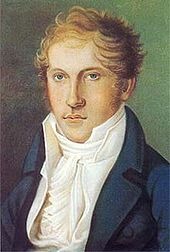 Louis Spohr (1784-1859), actually born Ludwig Spohr in Braunschweig, was a German composer, violinist and conductor. Early violin studies secured employment with Duke Karl Wilhelm Ferdinand of Brunswick, and barely 16 years old, Spohr accompanied his teacher Franz Eck on a concert tour, which took him as far as Saint Petersburg. But his musical star really rose after December 1804 performance in Leipzig. The highly influential music critic Friedrich Rochlitz was in the audience and Spohr’s playing supposedly brought him “to his knees.”
Louis Spohr (1784-1859), actually born Ludwig Spohr in Braunschweig, was a German composer, violinist and conductor. Early violin studies secured employment with Duke Karl Wilhelm Ferdinand of Brunswick, and barely 16 years old, Spohr accompanied his teacher Franz Eck on a concert tour, which took him as far as Saint Petersburg. But his musical star really rose after December 1804 performance in Leipzig. The highly influential music critic Friedrich Rochlitz was in the audience and Spohr’s playing supposedly brought him “to his knees.”
He was on friendly terms with Beethoven, and on the recommendation of Carl Maria von Weber became director of music at the court in Kassel. However, Spohr was not only a fabulous violinist, he was also a prolific composer. Among his roughly 300 works we find symphonies, operas, oratorios and 36 string quartets. In addition we find duos, trios, quintets, sextets, an octet and a nonet, alongside a number of works for solo violin and for solo harp. And then there are a number of compositions for violin and harp to be played by him and his wife. In his time, Spohr was rightfully most famous for his eighteen violin concertos and his treatise on violin playing that became a standard work of instruction. He is said to have invented the violin chinrest in 1820, and as a conductor he was one of the first to use a baton and he also invented rehearsal letters. So how then does a world-famous violinist get involved in writing 4 concertos for the clarinet?
Louis Spohr: Clarinet Concerto No. 1 in C minor, Op. 26
It’s not as complicated as it sound, as the newly invented instrument was at an important stage of development. Various changes to the design of the clarinet finally ensured a proper response throughout its register, and Johann Simon Hermstedt, one of the most famous clarinetists of the 19th century essentially commissioned the concertos. Spohr’s background as a violinist strongly informs the way he writes for clarinet. He demonstrates a sure handling of the special qualities of contrasting registers, and its effectiveness in arpeggios, rapid scales and ornamentation. Agile technical displays aside, Spohr’s clarinet concertos always adhere to the sustained operatic lyricism that also informs his violin compositions.
You May Also Like
- Unsung Concertos
Thomas Tellefsen: Piano Concerto No. 2 Like many young and talented Nordic musicians, Thomas Dyke Acland Tellefsen (1823-1874) was drawn to the city of Paris. - Unsung Concertos
Alexander Scriabin: Piano Concerto in F-Sharp Minor, Op. 20 During his lifetime, Scriabin was primarily known as a pianist, with Igor Stravinsky marveling at his phenomenal playing. - Unsung Concertos
Jacques Ibert: Flute Concerto If you think that all classical music has to be deadly serious, let me introduce you to Jacques Ibert (1890-1962). Ibert was a graduate from the Paris Conservatoire. - Unsung Concertos
Johann Matthias Sperger: Horn Concerto in E flat Throughout the 18th and 19th centuries, the city of Vienna acted like a gigantic magnet for composers and musicians.
More Anecdotes
- A Tour Around Vienna
Suppé: Ein Morgen, ein Mittag, ein Abend in Wien A work by the youthful Suppé -
 Desdemona in Real Danger What happened between Manuel Garcia and his daughter Maria Malibran?
Desdemona in Real Danger What happened between Manuel Garcia and his daughter Maria Malibran? -
 Adelina Patti and Her Teacup Puppy How would you respond if you receive a Chihuahua puppy after a performance?
Adelina Patti and Her Teacup Puppy How would you respond if you receive a Chihuahua puppy after a performance? - The Concerto Wrapped in Butter
Ignaz Moscheles: Piano Concerto No. 3 in G minor Funny anecdote between Ignaz Moscheles and his maid


